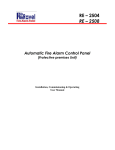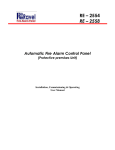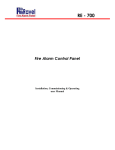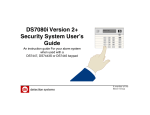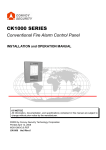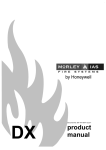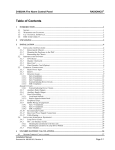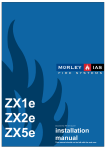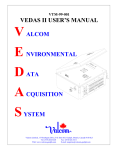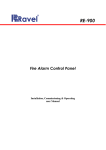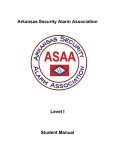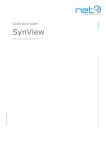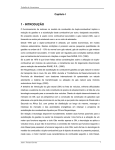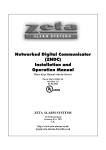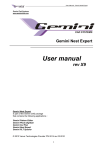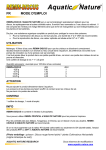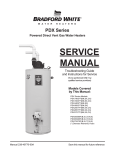Download Instruction Manual
Transcript
RE – 25AR Agent Release Control Panel (Protective premises Unit) Installation, Commissioning & Operating User Manual Fire Alarm System Limitations An automatic fire alarm system–typically made up of smoke detectors, heat detectors, manual Call Points, audible warning devices, and a fire alarm control with remote notification capability–can provide early warning of a developing fire. Such a system, however, does not assure protection against property damage or loss of life resulting from a fire. The Manufacturer recommends that smoke and/or heat detectors be located throughout a protected premise following the recommendations of the current edition of the National Fire Protection Association Standard 72 (NFPA 72), manufacturer's recommendations, State and local codes, and the recommendations contained in the Guide for Proper Use of System Smoke Detectors, which is made available at no charge to all installing dealers. A study by the Federal Emergency Management Agency (an agency of the United States government) indicated that smoke detectors may not go off in as many as 35% of all fires. While fire alarm systems are designed to provide early warning against fire, they do not guarantee warning or protection against fire. A fire alarm system may not provide timely or adequate warning, or simply may not function, for a variety of reasons: Smoke detectors may not sense fire where smoke cannot reach the detectors such as in chimneys, in or behind walls, on roofs, or on the other side of closed doors. Smoke detectors also may not sense a fire on another level or floor of a building. A second-floor detector, for example, may not sense a first-floor or basement fire. Particles of combustion or "smoke" from a developing fire may not reach the sensing chambers of smoke detectors because: • Barriers such as closed or partially closed doors, walls, or chimneys may inhibit particle or smoke flow. • Smoke particles may become "cold," stratify, and not reach the ceiling or upper walls where detectors are located. • Smoke particles may be blown away from detectors by air outlets. • Smoke particles may be drawn into air returns before reaching the detector. The amount of "smoke" present may be insufficient to alarm smoke detectors. Smoke detectors are designed to alarm at various levels of smoke density. If such density levels are not created by a developing fire at the location of detectors, the detectors will not go into alarm. Smoke detectors, even when working properly, have sensing limitations. Detectors that have photoelectronic sensing chambers tend to detect smoldering fires better than flaming fires, which have little visible smoke. Detectors that have ionizing-type sensing chambers tend to detect fast-flaming fires better than smoldering fires. Because fires develop in different ways and are often unpredictable in their growth, 1 RE / UM / 25AR V 1.0- 00 neither type of detector is necessarily best and a given type of detector may not provide adequate warning of a fire. Smoke detectors cannot be expected to provide adequate warning of fires caused by arson, children playing with matches (especially in bedrooms), smoking in bed, and violent explosions (caused by escaping gas, improper storage of flammable materials, etc.). While a fire alarm system may lower insurance rates, it is not a substitute for fire insurance! Heat detectors do not sense particles of combustion and alarm only when heat on their sensors increases at a predetermined rate or reaches a predetermined level. Rate-of-rise heat detectors may be subject to reduced sensitivity over time. For this reason, the rate-of-rise feature of each detector should be tested at least once per year by a qualified fire protection specialist. Heat detectors are designed to protect property, not life. IMPORTANT! Smoke detectors must be installed in the same room as the control panel and in rooms used by the system for the connection of alarm transmission wiring, communications, signaling, and/or power. If detectors are not so located, a developing fire may damage the alarm system, crippling its ability to report a fire. Audible warning devices such as bells may not alert people if these devices are located on the other side of closed or partly open doors or are located on another floor of a building. Any warning device may fail to alert people with a disability or those who have recently consumed drugs, alcohol or medication. Please note that: • Strobes can, under certain circumstances, cause seizures in people with conditions such as epilepsy. • Studies have shown that certain people, even when they hear a fire alarm signal, do not respond or comprehend the meaning of the signal. It is the property owner's responsibility to conduct fire drills and other training exercise to make people aware of fire alarm signals and instruct them on the proper reaction to alarm signals. • In rare instances, the sounding of a warning device can cause temporary or permanent hearing loss. A fire alarm system will not operate without any electrical power. If AC power fails, the system will operate from standby batteries only for a specified time and only if the batteries have been properly maintained and replaced regularly. Equipment used in the system may not be technically compatible with the control. It is essential to use only equipment listed for service with your control panel. 2 RE / UM / 25AR V 1.0- 00 The most common cause of fire alarm malfunction is inadequate maintenance. To keep the entire fire alarm system in excellent working order, ongoing maintenance is required per the manufacturer's recommendations, and UL and NFPA standards. At a minimum, the requirements of NFPA 72 shall be followed. Environments with large amounts of dust, dirt or high air velocity require more frequent maintenance. A maintenance agreement should be arranged through the local manufacturer's representative. Maintenance should be scheduled monthly or as required by National and/or local fire codes and should be performed by authorized professional fire alarm installers only. Adequate written records of all inspections should be kept. NFPA Standards This control panel complies with the following NFPA standards: • NFPA 12 - CO2 Extinguishing Systems (High Pressure Only) • NFPA 12A - Halon 1301 Extinguishing Systems • NFPA 72 - Local Fire Alarm Systems (Automatic, Manual, Waterflow and Sprinkler Supervisory) • NFPA 2001 - Clean Agent Fire Extinguishing Systems Underwriters Laboratories Documents • UL 38 - Manually Actuated Signaling Boxes • UL 217 - Smoke Detectors, Single and Multiple Station • UL 228 - Door Closers - Holders for Fire Alarm Systems • UL 268 - Smoke Detectors for Fire Alarm Systems • UL 268A - Smoke Detectors for Duct Applications • UL 346 - Waterflow Indicators for Fire Protective Signaling Systems • UL 464 - Audible Signaling Appliances • UL 521 - Heat Detectors for Fire Protective Signaling Systems • UL 864 - Standard for Control Units for Fire Alarm Systems • UL 1481 - Power Supplies for Fire Protective Signaling Systems • UL 1638 - Visual Signaling Appliances • UL 1971 - Signaling Devices for the Hearing Impaired 3 RE / UM / 25AR V 1.0- 00 NOTES: 4 RE / UM / 25AR V 1.0- 00 Table of Contents CHAPTER 1: Introduction ………….......................……......................8 1.1: System Design & Planning..........................................................8 1.2: General .………............................................................................8 1.3: Fire Alarm Procedure …..............................................................8 1.4: User Responsibility…....................................................................9 1.5: Routine test............…....................................……………………..9 CHAPTER 2: Product Description ...........................……...................10 2.1: Product Features ........................................................................11 2.2: Specifications .....................................................................…….13 2.3: Controls and Indicators .............................................................15 2.3.1: Controls …………………………………………………………….15 2.3.2: Indication ……………………………………………………..…...16 2.3.2.1 LED Indication……………………………………………………16 2.3.2.2.: LCD Indication …………………………………………………17 2.3.2.3: Local Buzzer …………………………………………………......17 2.4: Mechanical Construction……………………………………..…...17 2.5: Internal Arrangement…………………………….…………………18 2.6: Components……………………………………………...................19 CHAPTER 3: Installation .............................................……..........……21 3.1: Installation Precaution………………………….…………..………21 3.2: Mounting Details ..................................................…………..……22 3.3: Panel Wiring…………………………………………….……………..23 3.4: Initiating Device Circuits............................................……………28 3.5: Output Circuits .....................................................................…….29 3.5.1: Notification Appliance Circuit …………………………………..29 3.5.1: Releasing Appliance Circuit ……………………………………..30 3.5.2: 24V D.C Power ………………..……………………………………30 3.6: Standard Relay Output ……………………………………….........31 CHAPTER 4: Programming Instructions ………………………………...32 4.1: Menu Key Flow Diagram …………………………………………....32 4.2: Programming……………………………..........................................35 4.2.1. Set Zone Mode …………………………………………………36 4.2.2. Suppressed Supervisory ………...…………………... ……….37 4.2.3. Suppressed Fault Events ………..…………………………….38 4.2.4. Fire & Release Events …………………………………………..38 4.2.5. Fault Events …….……………………………………………......38 4.2.6. RAC 1 Mode …………………………………………………….39 4.2.7. RAC 2 Mode …………………………………………………….39 4.2.8. Pre Release ………………………………………………………39 4.2.9. RAC Off Time ……………………………………………………39 4.2.10. Remote Release ………………………………………………..40 4.2.11. Input 1 Type………………………………………………………40 5 RE / UM / 25AR V 1.0- 00 4.2.12. 4.2.13. 4.2.14. 4.2.15. 4.2.16. 4.2.17. 4.2.18. 4.2.19. 4.2.20. 4.2.21. 4.2.22. 4.2.23. 4.2.24. 4.2.25. 4.2.26. 4.2.27. 4.2.28. 4.2.29. 4.2.30. 4.2.31. 4.2.32. 4.2.33. 4.2.34. 4.2.35. 4.2.36. 4.2.37. Input 2 Type…………………………………………………….40 Input 3 Type…………………………………………………….41 Input 4 Type…………………………………………………….41 Mode Select …………………………………………………..42 Relay 1 Output ………………………………………………..42 Relay 2 Output ………………………………………………..42 Relay 3 Output ………………………………………………..42 NAC O/P Alarm ……………………………………………….43 NAC O/P Pre Release ………………………………………..43 NAC O/P Released …………………………………………..43 NAC 1 Output ………………………………………………….44 NAC 2 Output ………………………………………………….44 Zone Wiring ……………………………………………………..44 Supervisory Mode ……………………………………………...45 Walk Test …………………………………………………………45 Auto Silence …………………………………………................45 Silence Inhibit ………………………………………………......46 AC Loss Delay …………………………………………………..46 Trouble Remainder ……………………………………………46 24V Output ……………………………………………………..47 Set Date …………………………………………………………47 Set Time ………………………………………………………….47 Change User Password ……………………………………….48 Change Admin Password …………………………………….48 Restore Default Settings ……………………………………….49 About ……………………………………………………………..49 CHAPTER 5: Operating Instructions......................................................50 5.1: Switch Functions ……………………...............................................50 5.2: Indications ....................................….........................………………51 5.3: Operation..................................................................………………53 5.3.1: Normal Monitoring Mode………………………………………….53 5.3.2: Fire Alarm Condition.............................................….. ………….53 5.3.3: Supervisory …………………………………………………………..54 5.3.4: Fault………………………….………………………………………..55 5.3.5. Disable / W.T…………………………………………………………56 5.3.6: Manual Abort ……………………………………………………….57 5.3.7: Manual Release ……………………………………………………57 5.3.8: Pressure Switch ……………………………………………………..57 5.3.9: Alarm Verification ………………………………………………….58 5.3.10: Gas Release ……………………………………………………….59 CHAPTER 6: Servicing……………………………..……………………….60 6.1: Installation / Replacement of PCB……………………..………….60 6.2: Lamp Test…………………………………………………...................62 6.3: Walk test…………………………………………………………………62 6.4: System Power / Size …………………………………..……………….63 6 RE / UM / 25AR V 1.0- 00 6.5: Trouble Shooting ………………………………………………………63 CHAPTER 7: Battery Calculation ………..….……….………….………..64 CHAPTER 8: wire Requirement………………..…………………………..65 CHAPTER 9: Compatible Devices ……….………….……………………66 CHAPTER 10: Abbreviation …………………………………………………67 7 RE / UM / 25AR V 1.0- 00 Chapter 1: Introduction The RE – 25AR Agent Release Control Panel performs the functions of fire suppression in a wide variety of applications. The panel has capable to use in an agent release sprinkler system. It can be used as single – hazard or dual – hazard application with or without cross-zoning. This manual is intended as a complete guide to the Agent Release Control Panels. This manual provides complete information on installation, commissioning, Operating Instructions, programming guide, service, and maintenance procedures with full technical details. 1.1 System Design and Planning It is assumed that the system, of which this control panel is a part, has been designed by a competent fire alarm system designer in accordance with the requirements of NFPA – 72 and any other local codes of practice that are applicable. The design drawings should clearly show the positions of the field devices and the control equipment. 1.2 General The panel is self-contained with integral power supply and space provision for two sealed lead-acid standby batteries and complies with the requirements of NFPA – 72. The panel’s functions are microprocessor controlled and test and disable functions are included. The panel can accept, per zone, automatic detectors with a total maximum loading of 2mA quiescent current rating (refer to chapter 2.2), and an unlimited number of manual call points. The panel includes common alarm, supervisory, and trouble relays, and provides regulated and unregulated auxiliary power along with four-wire smoke power. It supports auxiliary relays and a city tie module. The auxiliary relays are based on a hazard area status. The RE – 25AR has six input zones and four output zones, allowing for flexibility in most single and dual hazard application for agent releasing applications. Installation The panel is easy to install and operate. Control functions Programming functions are enabled by using password. The panel fascia is retained by tamper-proof screws. 1.3 Fire Alarm Procedures In accordance with NFPA – 72, written procedures should be laid down for dealing with alarms of fire, fault warnings, and the isolation of any part of the system. The responsible person should ensure that users of the system are instructed in its proper use and are familiar with the procedures. 8 RE / UM / 25AR V 1.0- 00 On hearing the fire alarm: CARRY OUT THE PRESCRIBED PROCEDURE Subsequent actions will depend on the circumstances, and may include silencing the audible alarms and resetting the system, as described later. To Evacuate the premises: Press the Evacuate key and enter the password to OPERATE NAC’s (Sounders). Fault Indication: If the control panel indicates a Fault condition, make a note of all illuminated indicators and proceed as described in chapter 6 (Section 6.5) or call service engineer. 1.4 User Responsibility In addition to the routine testing described on routine test, the user has a responsibility for ensuring certain actions are taken following a fire or fault, and for implementing remedial action following a specified incidence of false alarms. As a minimum, the user shall record any incident and inform the service organization, who may be required to retest the system. 1.5 Routine Testing In order to ensure that the system is fully operational, and to comply with the requirements of UL864 Standard & NFPA – 72, the following routine attention is recommended: Daily - Check the panel to ascertain that it indicates normal operation. If any fault is indicated check that it has been recorded and the appropriate actions have been taken e.g. informing to the maintaining company. Weekly - Test at least one detector or call point to confirm the operation of the panel and the audible alarms. Test a different zone each week and, if possible, a different device. Keep a record of the device and zone tested each week. Record and report any malfunction. Quarterly - The responsible person should ensure that every three months the system is checked by a competent person. Check the standby batteries and the charger voltage Test at least one device in each zone to check the panel functions. Check the operation of the audible alarms and any link to a remote manned centre, Central Station, etc. Carry out a visual inspection of the installation to check for alterations or obstructions and issue a certificate of testing. Annually - The responsible person should ensure that, in addition to the quarterly checks, each device on the system is tested and that a visual inspection is made of the cable fittings and equipment. Note: The control panel cabinet should be cleaned periodically by wiping with a soft, damp cloth. Do not use any solvents. 9 RE / UM / 25AR V 1.0- 00 Chapter 2: Product Description The RE – 25AR Agent Release Control Panel performs the functions of fire suppression in a wide variety of applications. It can be used as single – hazard or dual – hazard application with or without cross-zoning. The panel includes common alarm, supervisory, and trouble relays, and provides unregulated auxiliary power along with four-wire smoke power. The auxiliary relays are based on a hazard area status. The RE – 25AR has eight inputs and four outputs, allowing for flexibility in most single and dual hazard application for agent releasing applications. 10 RE / UM / 25AR V 1.0- 00 2.1 Product Feature 4 Class B initiating device circuit (IDC). All zones accept smoke detectors and any normally open contact device. Any Zone can be configured as Alarm or supervisory Zone. 2 Class B Releasing Agent Circuits (RAC). 2 Class B Notification Appliance Circuits (NAC). Fully complies with UL -864 9th Edition and NFPA-72. Rugged CRCA sheet with powder coated finish. Operates on 120 - 220v 60 / 50 Hz, AC Mains power supply. Standby (battery) backup 24v DC power supply with built in charger 16x2 Dot Matrix LCD Display. Error free Fire / Fault status in unambiguous colored LED indication. System ON indication. Main, Standby status audible and visual indication. Battery Low visual warning with audible tone. 3 Form–C programmable relays for fault / supervisory / Fire / Cross Zone / Gas Release. Programmable 24v D.C. Outputs. Programmable Mode (Auto/Manual) Selection Programmable RACs. Lamp Test facility. Walk Test facility. Zone Isolation facility with loop voltage cut off. Earth fault annunciation facility at 0 ohms. All field wiring circuits are Power limited except 120 / 220v AC and Battery. All field wiring circuits are supervised. AC Low voltage cutoff. Programmable NAC’s. Programmable IDC’s. Programmable Supervisory Mode. Programmable AC loss delay. Alarm verification facility. Programmable Trouble reminder facility. 11 RE / UM / 25AR V 1.0- 00 Power Limited Programmable Inputs 1 & 2and RAC1 Power Limited Programmable Inputs 3 & 4 and RAC 2 ZONE - 4 _ + ZONE - 3 _ + ZONE - 2 _ + ZONE - 1 _ + CN 11 Relay 3 NC NO C Non-supervised Power Limited Power Limited Resettable 24V DC O/P INPUT - 4 INPUT - 3 RAC - 2 INPUT - 2 INPUT - 1 RAC - 1 OU T OU T _ OU T OU T _ IN CNA 12 IN + CN 14 IN IN CN 12 + CN 13 24V-SEN OU T IN CN 9 24 V O /P _ + CN 10 NAC - 2 NAC - 1 _ _ + CN 8 + CN 7 FIRE RELAY NC CN 5 NO C PRO G-RLY2 NC NO C CN 4 Relay 1 NC NO C Non-supervised Power Limited Primary Source 120/ 220 AC 60/50 Hz PRO G-RLY1 NC NO C CN 6 F3 F7 Q8 F6 Q9 F5 Q10 F4 DC INPUT Power Limited Zone Terminals Zone 1 to 4 Relay 2 NC NO C Non-supervised Power Limited Power Limited 24V NAC 1 &2 Output Q 12 CN 1 U7 U6 U8 U9 CN 3 Q1 24 V BAT I N F1 Fuse1 CN 2 26 Pin FRC Front Sticker Standby Source 12V 12Ah Battery Standby Source 12V 12Ah Battery Figure – 1 12 RE / UM / 25AR V 1.0- 00 2.2 Specification Primary Power (RE-SMPS-4A-R1) 120 - 220VAC + 10% -15%, 60 / 50 Hz, 2.5Amps. Standby Power 24v D.C (2 Nos of 12v, 12Ah Sealed Lead acid battery). Operating Condition Operating Temperature – 0 - 49° C / 32 - 120° F. Relative Humidity – 93 ± 2% RH (non-condensing) at 32 ±2° C/95 ±3°F. Charging Circuit Charging Voltage – 28V, ±0.5V Charging Current – 800mA (Max.). Initiating Device Circuits - CN11 All zones are Class B Style B/C operation (Programmable). Normal Operating Voltage: 14 - 21 VDC. Alarm Current: 15 – 30mA. Short Circuit Current: 45mA Maximum. Loop resistance: 100 ohms Maximum. End-Of-Line Resistor: 3K9, 1/2watt Standby Current: 7mA (2mA for Detectors) Note: For compatible devices refer Chapter 9(CD 01). Notification Appliance Circuits – CN 7 & 8 Class – B Style - Y wiring Operating Nominal Voltage: 24VDC – Special Application Current for all NACs: 1.2Amps (0.6A per circuit) Current Limit: via Thermal Fuse Line Drop: 1.8V End-Of-Line Resistor: 3K9, 1/2watt Note: For compatible devices refer Chapter 9(CD 01). Releasing Appliance Circuits – CN 13 & 14 Class – B Style - Y wiring 13 RE / UM / 25AR V 1.0- 00 Operating Nominal Voltage: 24VDC – Special Application Current for all RACs: 1.2Amps (0.6A per circuit) Current Limit: via Thermal Fuse Line Drop: 1.8V End-Of-Line Resistor: 3K9, 1/2watt D.C. Power – CN10 Operating Voltage: Supervised 24VDC regulated, 300mA Max. (for 4 wire smoke detector) Common Three Form – C Relays – CN4, CN5, CN6 Relay Contact Rating: 2Amps @ 30 VDC, 2Amps @ 30VAC. Power Factor: 0.6 Programmable Input circuits No. of Inputs: 4 Normal Operating Voltage: 8 - 12 VDC. Short Circuit Current: 5mA Maximum. Loop resistance: 100 ohms Maximum. End-Of-Line Resistor: 3K9, 1/2watt Standby Current: 2.5mA Total No. of Devices: 3 (for Manual Release & Actuator Pressure Low) during combination only. 14 RE / UM / 25AR V 1.0- 00 2.3 Control and Indication Figure – 2 2.3.1. Controls: ACK. Key: To mute local buzzer in alarm condition. To mute local buzzer in Supervisory or fault condition. User or Admin password protected. SILENCE Key: To silence the external NACs in Fire Condition. User or Admin password protected. RESET Key: To reset the particular zones in Fire alarm or Latched Supervisory condition. User or Admin password protected. Possible to access only after silence in alarm condition. DRILL: To activate External NACs Manually. User or Admin password protected. 15 RE / UM / 25AR V 1.0- 00 CURSOR KEYS: To move the cursor point in the LCD as required and increase and decrease the values. ENTER Key: To accept the programmed or edited menu, mode or value in the LCD. MENU Key: To enter into the Main Menu in the LCD. ESC: To go back to the previous screen or erase the password entered. 2.3.2. 2.3.2.1 Indications: LED indication System On – Green Fire – Red Fault – Yellow Supervisory – Yellow Mains Fail – Yellow Battery Fail – Yellow Earth Fault – Yellow System Fault – Yellow Disable – Yellow DC O/P Fault – Yellow Manual Mode – Yellow Silenced – Yellow NAC Fault – Yellow Walk Test – Yellow RAC Fault – Yellow Pre Release – Green Pressure Low – Yellow Man. Release – Red Abort – Yellow Released – Red 16 RE / UM / 25AR V 1.0- 00 Zone Fire – Red Zone Supervisory – Yellow Zone Fault – Yellow 2.3.2.2 LCD Indication The LCD is mainly used for the programming of the panel. It also indicates all events along with the LED indications except system on and system fault. 2.3.2.3 Local Buzzer A piezo buzzer provides separate and distinct sounds for alarm, trouble and supervisory conditions: 2.4 Alarm – Continuous Fault – pulse 0.5sec ON and 5sec OFF Supervisory – pulse 0.25sec ON and 0.25sec OFF Mechanical Construction The enclosure of the Panel is constructed by 18 gauge (1.22mm) CRCA sheet with powder-coated finish. The ∅22.25mm (∅19mm [11No’s] for Indian Std.) 10no’s of knockouts are given for cable entry at the top of the cabinet. The lockable hinged door is provided to access the inside the cabinet. The panel also has sufficient space to accommodate 2 Nos. of 12v, 12Ah batteries. 350 MM 120 MM 440 MM Figure – 3 17 RE / UM / 25AR V 1.0- 00 Top View mm 10 No’s mm 10No’s 120mm 350mm 7mm 18mm LHS View Front View RHS View 440 mm Botton View Figure – 4 2.5 Internal Arrangement Non Power Limited Cable Entry Wire Size = ‘X’ AWG CON 2 ontrol y&C Displa oard B 25A L-RE(RAVE CON 2 Master Board Power Supply Board (RAVEL-RE-25AR-MB-R1) (RAVEL-RE-SMPS-4A-R1) -R1) R-DISP 12v 12Ah Sealed Lead Acid Battery 12v 12Ah Sealed Lead Acid Battery Figure – 5 18 RE / UM / 25AR V 1.0- 00 Components Master Board (RE – 25AR – MB – R1) 225 mm ZONE - 4 _ + ZONE - 3 _ + ZONE - 2 _ + ZONE - 1 _ + CN 11 INPUT - 4 INPUT - 3 RAC - 2 INPUT - 2 INPUT - 1 RAC - 1 OUT OUT _ OUT OUT _ IN CNA 12 IN + CN 14 IN IN CN 12 24V-SEN OUT + CN 13 24V O/P _ IN CN 9 + CN 10 NAC - 2 NAC - 1 _ _ + CN 8 + CN 7 RELAY 3 NC CN 5 NO RELAY - 2 C NC NO RELAY - 1 C CN 4 NC NO C CN 6 F3 F5 Q9 Q10 F4 Q12 CN 1 136 mm Q8 F6 DC INPUT F7 125 mm U7 U6 U9 U8 CN 3 Q1 24V BAT IN F1 Fuse1 CN 2 236 mm Figure – 6 The Zone board contains the primary components and wiring interface connectors. Display Board (RE – 25AR – DISP-R1) The Display Board contains the system CPU, LED Display, LCD unit and 146 mm Control keys. 73 mm 162 mm 2.6 Figure – 7 19 RE / UM / 25AR V 1.0- 00 Power Supply (RE – SMPS – 4A – R1) Figure – 8 This Power supply gives the 30V DC output for the Zone Board. This board is SMPS type, it gives the output for 2.5Amps Max (4Amp During Initial condition). Cabinet The Cabinet measures 440mm width X 340mm Height X 120mm Depth and space is provided for 2 x 12 Volt 12Ah Batteries, main circuit board and display board. 20 RE / UM / 25AR V 1.0- 00 Chapter 3: Installation 3.1 Installation Precaution Installation Precautions WARNING - Several different sources of power can be connected to the fire alarm control panel. Disconnect all sources of power before servicing. Control unit and associated equipment may be damaged by removing and/or inserting cards, modules, or interconnecting cables while the unit is energized. Do not attempt to install, service, or operate this unit until this manual is read and understood. CAUTION - System Reacceptance Test after Software Changes. To ensure proper system operation, this product must be tested in accordance with NFPA 72 after any programming operation or change in site-specific software. Reacceptance testing is required after any change, addition or deletion of system components, or after any modification, repair or adjustment to system hardware or wiring. All components, circuits, system operations, or software functions known to be affected by a change must be 100% tested. In addition, to ensure that other operations are not inadvertently affected, at least 10% of initiating devices that are not directly affected by the change, up to a maximum of 50 devices, must also be tested and proper system operation verified. This system meets NFPA requirements for indoor dry operation at 0-49° C/32-120° F and at a relative humidity of 93 ±2% RH (non-condensing) at 32 ±2° C/95 ±3° F. However, the useful life of the system's standby batteries and the electronic components may be adversely affected by extreme temperature ranges and humidity. Therefore, it is recommended that this system and all peripherals be installed in an environment with a nominal room temperature of 15-32° C/60-95° F. Verify that wire sizes are adequate for all IDC’s loops. Most devices cannot tolerate more than a 10% I.R. drop from the specified device voltage. Adherence to the following will aid in problem-free installation with long-term reliability: Like all solid-state electronic devices, this system may operate erratically or can be damaged when subjected to lightning-induced transients. Although no system is completely immune from lightning transients and interferences, proper grounding will reduce susceptibility. Overhead or outside aerial wiring is not recommended, due to an increased susceptibility to nearby lightning strikes. Consult with the Technical Services Department if any problems are anticipated or encountered. 21 RE / UM / 25AR V 1.0- 00 Disconnect AC power and batteries prior to removing or inserting circuit boards. Failure to do so can damage circuits. Remove all electronic assemblies prior to any drilling, filing, reaming, or punching of the enclosure. When possible, make all cable entries from the sides or rear. Before making modifications, verify that they will not interfere with battery, transformer, and printed circuit board location. Do not tighten screw terminals more than 1.0168 N-m. Over-tightening may damage threads, resulting in reduced terminal contact pressure and difficulty with screw terminal removal. Though designed to last many years, system components can fail at any time. This system contains static-sensitive components. Always ground yourself with a proper wrist strap before handling any circuits so that static charges are removed from the body. Use static-suppressive packaging to protect electronic assemblies removed from the unit. Follow the instructions in the installation, operating, and programming manuals. These instructions must be followed to avoid damage to the control panel and associated equipment. FACP operation and reliability depend upon proper installation by authorized personnel. 3.2 Mounting Details 30 mm 284 mm 36 mm 30 mm 380 mm 30mm Figure – 9 22 RE / UM / 25AR V 1.0- 00 Remove all the Boards before placing the panel in its mounting position. Place the panel in its mounting position and fix the panel to the wall using the slots of the four screws. Ensure the enclosure and the inner parts of the panel are given sufficient protection during installation. Fix the all boards in its position (Refer Figure25, 26 & 27). All external cables are to be entered via the 20 numbers of preformed knockouts located at top of the panel. When the installation of all the cables has been completed, clean the interior of the enclosure ensuring all masonry debris and drilling swords are removed. 3.3 Panel Wiring Warning: Several different sources of power can be connected to this panel. Disconnect all sources of power before servicing. The panel and associated equipment may be damaged by removing and / or inserting cards, modules or inter connecting while this unit is energized. Primary Power source (AC) and Earth Ground Connections AC Power connections are made inside the control panel cabinet. The Primary source for the RE - 25AR is 120 - 220 VAC, 60 / 50 Hz, 2.5 Amps. Run a pair of wires with Earth conductor from the protected premises main breaker box to connector CON1 (RE – SMPS – 4A – R1) of the power supply board. As per National Electrical Code, use 14 AWG (2.00 mm2, 1.6mm O.D) or heavier gauge wire with 600V insulation. No other equipment may be connected to this circuit. In addition, this circuit must be provided with over current protection and may not contain any power disconnect devices. A separate Earth Ground connection must be made to ensure the proper panel operation and lighting and transient protection. Connect the Earth Ground wire (Min. 14AWG / 2.00 mm2) to the connector CON1. Standby Power Source (Batteries) Observe polarity when connecting the battery. Connect the battery cable to connector CN2 on the Zone board (RE – 25AR – MB – R1) using the connector and cable provided. The battery charger is current – limited and capable of recharging sealed lead acid type batteries upto 12Ah. During alarm condition, the charger section is disconnected from the battery hence there will not be any charging at that time. 23 RE / UM / 25AR V 1.0- 00 RE – 25AR Power Supply Circuit Board (RE – SMPS – 4A – R1) Figure - 10 RE – 25AR Power Supply Monitor Circuit Board (RE –Monitor) Figure – 11 24 RE / UM / 25AR V 1.0- 00 RE – 25AR Main Circuit Board (RE – 25AR – MB – R1) 26 Pin FRC to Display CN 3 _ _ + ZONE - 3 _ + ZONE - 2 Power Limited Zone Terminals Zone 1 to 4 + _ + ZONE - 1 Q8 OUT IN INPUT - 3 + F7 CN 14 _ RAC - 2 IN OUT Q9 IN INPUT - 1 + F6 CN 13 _ RAC - 1 + Q12 F3 CN 10 _ 24V O/P CN 7 _ + NAC - 1 CN 8 F4 + F5 _ NAC - 2 CN 5 NC NO C FIRE RELAY CN 4 NC C CN 2 NO C PROG-RLY1 NC CN 6 CN 1 Relay 2 NC NO C Non-supervised Power Limited 24V BAT IN NO PROG-RLY2 Relay 3 NC NO C Power Limited Non-supervised Resettable Power Limited 24V DC O/P Power Limited 24V NAC 1 &2 Output IN Q10 CN 9 OUT 24V-SEN Power Limited Solenoid O/P RAC1 Power Limited Programmable Inputs 1 & 2 CN 12 OUT INPUT - 2 Power Limited Solenoid O/P RAC2 Power Limited Programmable Inputs 3 & 4 IN INPUT - 4 OUT CNA 12 U7 U9 Fuse1 Relay 1 NC NO C Non-supervised Power Limited 30V DC Input from SMPS (Power Limited) RE / UM / 25AR V 1.0- 00 25 ZONE - 4 CN 11 U6 U8 Q1 F1 24V DC Standby Input (Power Limited) DC INPUT Figure – 12 Field Wiring Diagram D1 _ Zone 4 D1,D2 Bd1, Bd2 EOL NAC - Two wire detectors - Four wire detectors. - End Of Line Resistor - Notification Alarm Circuit _ + Zone 3 Bd1 D2 EOL Initiating Device Circuit IDC’s are 1 to 8, Class B StyleB/C End of Line - 3K9 1/2W PN: RE3K9 Bd2 _ + Zone 2 EOL _ + Zone 1 _ _ + IN Input 3 OUT _ + + RAC - 2 (0.6A) RE-Monitor + + Input 4 VALVE _ Input 2 _ + Input 1 _ + + RAC - 1 (0.6A) RS Sense OUT RS 24V Output (300mA) _ NAC - 2 (0.6A) _ + EOL _ + EOL NAC NAC + NAC - 1 (0.6A) IN NC Relay 3 NO NC Relay 2 NO NC Relay 1 NO 120 - 220V AC Input N 3 Potential Relays For Fire, Fault, Supervisory, Pre Release, Released - Power Limited outputs. Contact Rating: 2.0A @ 30VDC 2.0A @ 30VAC Power Factor: 0.6 Note: All the field wiring circuits are supervised. All the field wiring circuits are Power limited except 120-220v A.C and Battery. P Figure – 13 26 RE / UM / 25AR V 1.0- 00 73 mm 15 mm 110 mm 105 mm 15 mm 22.23 mm 60 mm Mounting OF RE - Monitor 19 mm 15 mm 60 mm 15 mm 90 mm Figure - 14 PCB PCB Mounting Hole Figure – 15 27 RE / UM / 25AR V 1.0- 00 3.4 Initiating Device Circuit No. of Initiating circuit : 4 Zone Type : Class B Style : B / C Programmable Wire Size : 1.5 sq. mm Max. Operating Voltage : 14 - 21 VDC Nominal (Max.) Terminal : CN11 Loop Resistance : 100 Ω Max. Total No. of Devices : 16 Monitoring Device Compatible Devices : : 3K9 (EOL) (Refer Chapter 9) Refer Chapter 9. All zones may be configured for general fire alarm applications or supervisory alarm zones. Four-wire smoke detectors may be connected to any zone. Resettable power is provided via CN10. Note: a. Only smoke detectors can be connected in the zone with alarm verification b. Only Same model detectors should be used in IDC. c. Manual Pull Station should not be used in the style ‘C’ mode. Warning: This unit includes an Alarm Verification Feature that will result in a delay of the system alarm signal from the indicated circuits. The total delay shall not exceed 80 Sec. no other smoke detector shall be connected to these circuits unless approved by the local authority having jurisdiction. E.O.L. RESISTOR 3K9 OHMS E.O.L. RESISTOR 3K9 OHMS SMOKE DETECTOR SMOKE DETECTOR HEAT DETECTOR HEAT DETECTOR Manual Call Point Manual Call Point E.O.L. RESISTOR 3K9 OHMS FOR UNUSED ZONE LOOPS Z4 Z3 Z2 Z1 Figure – 16 28 RE / UM / 25AR V 1.0- 00 Programmable Inputs: No. of Inputs :4 Normal Operating Voltage : 8 - 12 VDC. Short Circuit Current : 5mA Maximum. Loop resistance : 100 ohms Maximum. Wire Size Terminal : 1.5 sq. mm Max. : CN12 & CN 16 End-Of-Line Resistor : 3K9, 1/2watt Standby Current : 2.5mA Total No. of Devices : 3 (for Manual Release & Actuator Pressure Low) during combination only 3.5 Output Circuits 3.5.1 Notification Appliance Circuits No. of NAC Type Style Output Voltage Max. Line Drop Current Terminals Monitoring Device Wire Size Compatible Device : : : : : : : : : : 2 Ckts. Class B Y 24 V 1.8 V 0.6A (Each) CN7, CN8 3K9 (EOL) 1.5 sq. mm Max. Refer Chapter 9. EOL + + Non Polarized Sounder + Polarized Sounder NAC 2 NAC 1 Retain E.O.L Resistor 3K9 Ohms for unused circuits Figure – 17 29 RE / UM / 25AR V 1.0- 00 3.5.2 Releasing Appliance Circuits No. of RAC : Type : Style : Output Voltage : Max. Line Drop : Current : Terminals : Monitoring Device : Wire Size : 2 Ckts. Class B Y 24 V 1.8 V 0.6A (Each) CN13, CN14 3K9 (EOL) 1.5 sq. mm Max. EOL Non Polarized Valve NAC 2 NAC 1 Retain E.O.L Resistor 3K9 Ohms for unused circuits 3.5.3 24V D.C Power (300mA) Output Voltage Current Output Terminal Wire Size Monitoring Device Monitoring Terminal CN9 Link : : : : : : : 24 VDC Nominal 0.3A Max. CN10 1.5 sq. mm Max RE – MONITOR (Refer Chapter 9) CN9 3K9 Max. (Refer Chapter 9) NOTE: The Link should be disconnected after connecting monitoring device. RE - Monitor 24V DC Sense RS 24V I/P IN - + OUT IN - + OUT CN12 CN 7 RS - SEN RS 24V OP Fire Alarm Panel Figure – 18 (Resettable O/P) 30 RE / UM / 25AR V 1.0- 00 3.6 Standard Relay Output Circuits No. of Programmable Relay Output zone, Gas Release) : 3 (Fire, Fault, Supervisory, cross Contact Voltage : 30 VDC Nominal Current Rating : 2A Type of Relay : Form – C Relay 3 Relay 2 Relay 1 Relay 3 Relay 2 Relay 1 Relay contacts shown with power applied to the panel no active Fire or Gas Release If the relay is configured as fault, then it will reverse Relay contacts shown with power applied to the panel active Fire or Gas Release If the relay is configured as fault, then it will reverse Figure – 19 Figure – 20 31 RE / UM / 25AR V 1.0- 00 CHAPTER 4: Programming Instructions Notice to USERS, INSTALLERS. AUTHORITIES HAVING JURISDICTION, AND OTHER INVOLVED PARTIES This product incorporates field-programmable software. In order for the product to comply with the requirements in the Standard for control Units and Accessories for Fire Alarm Systems, UL 864, certain programming features or options must be limited to specific values or not used at all as indicated below. Program Feature or Option Permitted in UL 864? (Y/N) Possible settings Setting Permitted in UL 864 NAC O/P Alarm, Pre Release, Released Yes Temporal, Steady, Synchronized, 120 BPM Temporal, Steady, Synchronized 4.1 Menu Key Flow Diagram: Admin Password MENU KEY - FLOW DIAGRAM Me nu Key 1. Set Zone Mode 1 2 3 4 F S A W 2. Suppressed supe rvisory Sup-Suprv [X/Y ] Zone Z (If any fault) 3. Suppre ssed Fault Sup-Fault [X/Y] Fault (If any fault) Default Password: User: 1234 Admin: 54321 Use Cursor Key to view next / previous Events 4. Fir e & Rele ase Events Use Enter Key to view Events 5. Fault Ev ents Use Enter Key to view Events 6. RAC1 Mode Zone 1&2 Use Key to Type/Options 6. RAC1 Mode Zone 1 / 2 / 1or2 7. RAC2 Mode Zone 3&4 Use Key to Type/Options 7. RAC2 Mode Zone 3 / 4 / 3 or 4 / Disabled Use Cursor Key to view next / previous Events 8. Pre Rele ase 20 (Secs) Use Curso r Key to Increase / Decrease the ti me d el ay Use Key to Type/Options 8. Timer Delay Disabled 9. RAC Off Time 10 (Secs) Use Curso r Key to Increase / Decrea se the time d el ay Use Key to Type/Options 9. RAC Off Time Disabled 10. Rmt Release 10 (Secs) Use Cursor Key to Increase / Decrease the time dela y Use Key to Type/Options 10. Rmt Release Disabled Note: 1. Use Cursor key ( A 2. Use Enter Key ( 3. Use Cursor key ( ) to move the menu list and to interchange the status of the menu. ) to select the menu list and conform the change of the status. ) to change the value / options. 32 RE / UM / 25AR V 1.0- 00 MENU KEY - FLOW DIAGRAM A 11. I nput 1 Typ e Man Release - RAC1 Use Change Mode/Type Man Rel&Abrt-RAC1 12. Inp ut 2 Type Abort - RAC1 Use Change Mode/Type 12. Input 2 Type Man Release - RAC2 13. Inp ut 3 Type Pre ssure SW - RAC1 Use Change Mode/Type 13. In put 3 Type Disable d 14. I nput 4 Typ e P ressure S W- RAC2 Use Change Mode/Type 14. Input 4 Type Disabled 15. Mode Select Auto Use Change Mode/Type 15. Mode Select M anual 16. Relay 1 Output Fire 17. Relay 2 Output Fault 11. Input 1 Type Use Change Mode/Type 16. Relay 1 Output Supervisory 16. Relay 1 Output Released 16. Re lay 1 Output Pre Release Use Change Mode/Type 17. Relay 2 Output Rele ased 17. Relay 2 Output Pre Rele ase 17. Relay 2 Output Fire 17. Relay 2 Output Supervisory 18. Relay 3 Output Supervisory Use Change Mode/Type 19. NAC O/P-Alarm Temporal 20. NAC O/P-PreRl Steady 18. Relay 3 Output Released Use Change Mode/Type Use Change Mode/Type 18. Relay 3 Output Pre Release 19. NAC O/P-Alarm Synchronized 20. NAC O/P-PreRl Temporal 18. Relay 3 Output Fire 19. NAC O/P-Alarm Steady 20. NAC O/P-PreRl Synchr onized Note: 1. Use Cursor key ( B 2. Use Enter Key ( 3. Use Cursor key ( ) to move the menu list and to interchange the status of the menu. ) to select the menu list and conform the change of the status. ) to change the value / options. 33 RE / UM / 25AR V 1.0- 00 B MENU KEY - FLOW DIAGRAM 21. NAC O/P-Relsd Synchronized Use Change Mode/Type 21. NAC O/P-Re lsd Temporal 21. NAC O/P-Re lsd Steady 22. NAC1 Output RAC 1 Use Change Mode/Type 22. NAC1 Output Common 23. NAC2 Output RAC 2 Use Change Mode/Type 23. NAC2 Output Common 24. Zone Wiring Class-B Style-C Use Change Mode/Type 24. Zone Wiring Class-B Style-B 25. Suprvisory Mde Use Change Mode/Type 25. Suprvisory Mde Re se tta ble 26. Walk Test Audible Use Change Mode/Type 26. Walk Test Silent 27. Auto Silence Disabled Use Change Mode/Type 27. Auto Silence 120 (Secs) Use Cursor K ey to Increa se / De crea se the time del a y 28. Silence Inhbt Disabled Use Change Mode/Type 28. Silence Inhbt 060 (Secs) Use Cursor K ey to Increa se / De crea se the time del a y Latc he d Use C ursor Key to Increa se / Decrea se the ti m e del a y Use Cha nge Ke y to M ode/Type 29. AC Loss Dly 120 (Mins) 30. Trouble Remin 720 (Mins) Use C ursor Key to Increa se / Decrea se the ti m e del a y Use Cha nge Ke y to M ode/Type 30. Trouble Remin Disabled 29. AC Loss Dly 31. 24v O utput Re se tta ble Disable d 31. 24v Output Use Change Mode/Type Ste ad y 32. Se t Da te 24/12/10 DD/MM/YY Use Cursor Key to Increa se / De crea se the Da te 33. Set Time 10:10 HH : M M (24hrs) Use Cursor Key to Increa se / De crea se the ti me 34. Change Use r Pa ssw ord 35. Change Adm in Passw ord 36. Restore De fa ult Se ttin gs 37. Abort Enter Old Password? Enter New Passwor d? Confirm New Password? P a ssw ord Upda ted Enter Old Password? Enter New Passwor d? Confirm New Password? P a ssw ord Upda ted !W arning! P re ss ENTER To re store Password? Resetting... Model: RE-25AR Version 1.0 Note: 1. Use Cursor key ( 2. Use Enter Key ( 3. Use Cursor key ( ) to move the menu list and to interchange the status of the menu. ) to select the menu list and conform the change of the status. ) to change the value / options. 34 RE / UM / 25AR V 1.0- 00 4.2 Programming: The MENU key is used to enter into the programming mode for changing and configuring the Input & Output details and other settings. To enter into the menu, admin password is must. The various steps involved in this menu are shown as flow chart 4.1. After entering into the menu, screen will show the first menu as below, 1. Set Zone Mode To move the next menu use the left / right cursor key, and press Enter / ‘’ key to change the settings. The programmable menu list is as follows. 1. 2. 3. 4. 5. 6. 7. 8. 9. 10. 11. 12. 13. 14. 15. 16. 17. 18. 19. 20. 21. 22. 23. 24. 25. 26. 27. 28. 29. 30. 31. 32. 33. 34. 35. 36. 37. Set Zone Mode Suppressed Supervisory Suppressed Faults Fire & Release Events Fault Events RAC1 Mode RAC2 Mode Pre Release RAC Off Time Rmt Release Input 1 Type Input 2 Type Input 3 Type Input 4 Type Mode Select Relay 1 Output Relay 2 Output Relay 3 Output NAC O/P Alarm NAC O/P PreRl NAC O/P Relsd NAC1 Output NAC2 Output Zone Wiring Supervisory Mde Walk Test Auto Silence Silence Inhbt AC Loss Dly Trouble Remin 24V Output Set Date Set Time Change User Password Change Admin Password Restore Default Settings About 35 RE / UM / 25AR V 1.0- 00 4.2.1 Set Zone Mode From the Set Zone Mode program screen, By pressing the “Enter” key the system enters into the zone set mode. In this mode the zone mode can be changed to fire, supervisory, alarm verification, walktest and disable mode. After entering the zone mode, screen will be as below. 1 2 3 4 Y Y Y Y Y = F / S / A / W / D mode. F – Fire, S – Supervisory, A – Alarm Verification, W – Walk test, D - Disable The zone is selected by using the right / left arrow keys, the mode can change using the ‘’ key. Then press the “Enter” key to accept the changes. This process can be continued in case of other zone to be changed. Note: 1. At the time of Fire/Supervisory events in a fire / supervisory mode set zone, that particular zone mode can only be disabled. 2. To come out of the menu configuration press ‘ESC’ key. Fire Mode: In this mode the zone will be in normal condition to detect the fire with detectors and manual pull station (normally open devices). This mode is represented as ‘F’ at the time of setting. Supervisory Mode: In this mode the zone will detect normally open devices. The optional feature of selecting resettable / latching mode. This mode is represented as ‘S’ at the time of setting. Disable Mode: In this mode the zone is disabled with loop voltage cut off. This mode is represented as ‘D’ at the time of setting. Note: Avoid disabling any zone unless it is really essential. Walk test: In this mode the selected zone is used to check all the loop devices manually one by one. The signal from the Initiating device will cause the panel in the alarm mode. The panel automatically get silenced and reset after a specific period without activating the fire relay. In this mode reset is done for only that particular zone. When entering into this mode the Fire relay output disablement is activated automatically and it will go back to previous status while we are coming out from this mode. For other zones that are not in walk test mode, if they sense any fire, then the panel will go to normal alarm mode and walk test zone changed to alarm mode automatically. 36 RE / UM / 25AR V 1.0- 00 This feature helps to perform the testing of devices by a single person. In this mode if the zone detects any fire then after 4 seconds the panel will get automatically silenced. After 2 seconds of silence, the zone will go to reset. This mode is represented as ‘W’ at the time of setting. Note1: a. If there is no more testing, please ensure that the zone is brought back to the normal Condition. b. To bring back the zone loop to normal condition, same procedure is followed as for the test. c. If the zone is kept in Walk test mode for 10 minutes with out any test the panel comes out of the walk test mode automatically. d. During test condition that the other zones that are not in test mode fire will consider as actual fire. Note2: 1. The supervisory mode is selected only in Admin level. And mode changing from supervisory to fire mode is also under admin level. 2. After changing the mode should press the ENTER key. Otherwise the change will not accept. 3. Avoid disabling any particular zone unless it is giving any false alarm / Fault Condition / Reworking 4. For zone disabling and their normalization, use same procedure as for the disable. Alarm Verification: In this mode, the detectors connected in the selected zone are used to check and confirm that smoke detector activates the verification alarm. The smoke detectors should be connected to the zone which going to select as for alarm verification. Note: Use only the alarm verification facility to zone loop in which the smoke detectors are used. If particular zone is selected for cross zone, then alarm verification will be removed automatically. 4.2.2 Suppressed Supervisory From the Suppressed Supervisory Event program screen, by pressing the “Enter” key the system enters into the Suppressed Fault Event. In this mode the suppressed Supervisory events can be viewed sequentially using the right / left arrow keys. After entering the suppressed Supervisory events, screen will be as below. 37 RE / UM / 25AR V 1.0- 00 Sup-Suprv [x /y] EVENT 4.2.3 X – nth Event; Y – Total Number of Event. Suppressed Fault From the Suppressed Fault Event program screen, By pressing the “Enter” key the system enters into the Suppressed Fault Event. In this mode the suppressed fault events other than fire events can be viewed sequentially using the right / left arrow keys. After entering the suppressed fault events, screen will be as below. Sup-Fault [x /y] EVENT X – nth Event; Y – Total Number of Event. Note: Through suppressed events feature you can view the fault occurred currently during alarm condition. 4.2.4 Fire & Release Events From the Fire & Release Events log screen, by pressing the “Enter” key the system enters into the Fire & Release Events log. In this mode the events of Fire and Agent Release can be viewed sequentially using the ‘’ arrow keys. After entering the Fire & Release Events log, screen will be as below. [A/B] Event DD/MM/YY HH:MM A – nth Event; B – Total Number of Event. 4.2.5 Fault Events From the Fault Events Log screen, by pressing the “Enter” key the system enters into the Fault Events Log. In this mode the events of Fault can be viewed sequentially using the ‘’ arrow keys. After entering the Fault Events Log, screen will be as below. [A/B] Event DD/MM/YY HH:MM A – nth Event; B – Total Number of Event. 38 RE / UM / 25AR V 1.0- 00 4.2.6 RAC 1 Mode From the RAC 1 Mode screen, the RAC1 Output shall be configured for Cross Zone (1&2) or Zone 1 or Zone 2 or Any one Zone (1 or 2). The RAC mode can be changed by using the ‘’ keys. The RAC1 Mode screen will be as below. 6. RAC1 Mode Zone 1&2 Note: This RAC1 Output is used only for Zone 1 & 2. 4.2.7 RAC 2 Mode From the RAC 2 Mode screen, the RAC2 Output shall be configured for Cross Zone (3&4) or Zone 3 or Zone 4 or Any one Zone (3 or 4) or Disabled. The RAC mode can be changed by using the ‘’ keys. The RAC2 Mode screen will be as below. 7. RAC2 Mode Zone 3&4 Note: This RAC2 Output is used only for Zone 3 & 4. 4.2.8 Pre Release The time delay to give the 24V output to release the gas through the RAC can be programmed. The time delay range is 1 to 60 Seconds. In this mode by pressing ‘Enter’ key it enters in to change mode. The first digit starts blinking, which can be changed by using the cursor key to increase or decrease the time then press the ‘Enter’ key to move the next digit. Now second digit starts blinking and does the same procedure to change the time. The LCD Display shows as follows. 8. Pre Release Disabled Note: This Time Delay is only for ‘Auto Mode’. 4.2.9 RAC Off Time Similar to the timer delay, the Solenoid 24V Output off time also programmable. The time delay range is 1 to 60 Seconds. In this mode by pressing ‘Enter’ key it enters in to change mode. The first digit starts blinking, 39 RE / UM / 25AR V 1.0- 00 which can be changed by using the cursor key to increase or decrease the time then press the ‘Enter’ key to move the next digit. Now second digit starts blinking and does the same procedure to change the time. The LCD Display shows as follows. 4.2.10 Rmt Release The time delay to give the 24V output to release the gas through the RAC can be programmed. The time delay range is 1 to 30 Seconds. In this mode by pressing ‘Enter’ key it enters in to change mode. The first digit starts blinking, which can be changed by using the cursor key to increase or decrease the time then press the ‘Enter’ key to move the next digit. Now second digit starts blinking and does the same procedure to change the time. The LCD Display shows as follows. 10. Rmt Release Disabled Note: This Time Delay is only for ‘Manual Mode’. 4.2.11 Input 1 Type This Input 1 is programmable as manual release of RAC1 or Manual release & Abort of RAC1. This Input is kept normally open, whenever the input changes to normally close; the ARP gives the appropriate Indication with audible tone. In this mode the screen is as shown below. 11. Input 1 Type Man Release-RAC1 If this mode is configured as ‘manual release – RAC1’, then in this input circuit the abort switch can’t be connected. If the mode is configured as ‘Man Rel&Abrt-RAC1’ (Manual release & Abort) then both Release and abort can connect in the same circuit for the output RAC 1. 4.2.12 Input 2 Type This Input 2 is programmable as Abort of RAC1 or Manual release & Abort of RAC2. This Input is kept normally open, whenever the input changes to normally close; the ARP gives the appropriate Indication with audible tone. In this mode the screen is as shown below. 12. Input 2 Type Abort - RAC 1 40 RE / UM / 25AR V 1.0- 00 If this mode is configured as ‘Abort – RAC1’, then in this input circuit the manual Release switch can’t be connected. If the mode is configured as ‘Man Rel&Abrt-RAC2’ (Manual release & Abort) then both Release and abort can connect in the same circuit for the output RAC 2. Note: For Inputs 1 & 2 (Manual Release Switch), Resistor 2K2 ½ watt should be placed in series. 4.2.13 Input 3 Type This Input 3 is programmable as pressure Switch of RAC1 or Disabled. This Input is kept normally open, whenever the input changes to normally close; the ARP gives the appropriate Indication with audible tone. The options for the ‘input 3 Type’ can be changed by pressing ‘’key from the panel key pad. In this mode the screen is as shown below. 13. Input 3 Type Pressure SW - RAC1 Is this mode is configured as ‘Pressure SW – RAC1’, then in this input circuit accept it as pressure status of the cylinder connected with the circuit RAC1 and give the appropriate indication. If the mode is configured as ‘Disabled’ then Gas release out put is sensed without pressure switch. 4.2.14 Input 4 Type This Input 4 is programmable as pressure Switch of RAC2 or Disabled. This Input is kept normally open, whenever the input changes to normally close; the ARP gives the appropriate Indication with audible tone. The options for the ‘input 4 Type’ can be changed by pressing ‘’key from the panel key pad. In this mode the screen is as shown below. 14. Input 4 Type Pressure SW - RAC2 Is this mode is configured as ‘Pressure SW – RAC2’, then in this input circuit accept it as pressure status of the cylinder connected with the circuit RAC2 and give the appropriate indication. If the mode is configured as ‘Disabled’ then Gas release out put is sensed without pressure switch. Note: For Actuator Pressure Low Switch, Resistor 2K2 ½ watt should be placed in series. 41 RE / UM / 25AR V 1.0- 00 4.2.15 Mode Select From the Mode Selection screen, Gas release output is configured as Auto or Manual. The options for the Mode Selection can be changed by pressing ‘’ key from the panel key pad. When you enter into this mode the screen will be as below. 15. Mode Select Auto 4.2.16 Relay 1 Output From the Relay 1 (Programmable Potential Free Relay) screen, The Programmable Relay 1 is configured for the following actions Fire, Supervisory, Cross Zone and Released. The options for the relay 1 can be changed by pressing ‘’key from the panel key pad. When you enter into this mode the screen will be as below. 16. Relay 1 Output Supervisory 4.2.17 Relay 2 Output Similar to the Relay 1 (Programmable Potential Free Relay) Relay 2 screen, The Programmable Relay 2 is configured for the following actions Fire, Supervisory, Cross Zone, Released and Fault. The options for the relay 2 can be changed by pressing ‘’ key from the panel key pad. When you enter into this mode the screen will be as below. 17. Relay 2 Output Fault 4.2.18 Relay 3 Output Similar to the Relay 1 (Programmable Potential Free Relay) Relay 3 screen, The Programmable Relay 3 is configured for the following actions Fire, Supervisory, Cross Zone and Released. The options for the relay 3 can be changed by pressing ‘’ key from the panel key pad. When you enter into this mode the screen will be as below. 42 RE / UM / 25AR V 1.0- 00 18. Relay 3 Output Supervisory 4.2.19 NAC O/P – Alarm The NAC output differentiated with four different tone like synchronized, temporal, Steady and it is configurable for the Alarm, Cross zone and Released. From the NAC O/P - Alarm (Notification Appliance Circuit Output) screen, The Type of Signal for NAC is configured as following Synchronized, Temporal, and Steady. The options for the NAC O/P - Alarm can be changed by pressing ‘’ key from the panel key pad. When you enter into this mode the screen will be as below. 19. NAC O/P-Alarm Synchronized 4.2.20 NAC O/P PreRl From the NAC O/P – Pre Release screen, The Type of Signal for NAC is configured as following Synchronized, Temporal and Steady. The options for the NAC O/P – Pre Release can be changed by pressing ‘’ key from the panel key pad. When you enter into this mode the screen will be as below. 20. NAC O/P-PreRl Temporal 4.2.21 NAC O/P Relsd From the NAC O/P - Released screen, The Type of Signal for NAC is configured as following Synchronized, Temporal and Steady. The options for the NAC O/P - Released can be changed by pressing ‘’ key from the panel key pad. When you enter into this mode the screen will be as below. 21. NAC O/P-Relsd Steady 43 RE / UM / 25AR V 1.0- 00 4.2.22 NAC 1 Output From the NAC 1 Output screen, The NAC 1 is configured for the circuit RAC1 or common. The options for the NAC 1 Output can be changed by pressing ‘’ key from the panel key pad. If the NAC1 is configured for RAC1 then it will turns on for zones related to RAC1 (Zone 1&2) and RAC circuit functions like Pre release and Released. When you enter into this mode the screen will be as below. 22. NAC1 Output RAC1 Note: NAC 1 can be configured as common for both circuits RAC 1 & 2 4.2.23 NAC 2 output From the NAC 2 Output screen, The NAC 2 is configured for the circuit RAC2 or common. The options for the NAC 2 Output can be changed by pressing ‘’ key from the panel key pad. If the NAC2 is configured for RAC2 then it will turns on for zones related to RAC2 (Zone 3&4) and RAC circuit functions like Pre release and Released. When you enter into this mode the screen will be as below. 23. NAC2 Output RAC2 Note: NAC 2 can be configured as common for both circuits RAC1 & 2 4.2.24 Zone Wiring From the Zone Wiring program screen, The zones circuit is designed for the class-B wiring. The style of wiring can be changed using this option. The Style of class-B can be changed as Style-B or Style-C by pressing ‘’ key from the panel key pad. When you enter into this mode the screen will be as below. 24. Zone Wiring Class-B Style-C 44 RE / UM / 25AR V 1.0- 00 4.2.25 Supervisory Mode From the Supervisory Mode program screen, The supervisory zones can be selected as resettable / latching mode. Press ‘’ to toggle between options. A supervisory zone, programmed for latching, requires manual reset to restore after the supervisory alarm is cleared. A supervisory zone, programmed for resettable, will be automatically restored after the supervisory alarm is cleared. 25. Superv isry Mde Resettable 4.2.26 Walk Test In this mode the NAC’s can programmed as Audible / Silenced by using the key ‘’ in this sceen. For an audible walktest, the panel detects any fire then after 4 seconds the panel will get automatically silenced. After 2 seconds, the panel will go to reset. This reset is done for only that particular zone. For an silenced walktest, the panel will not activate the NAC’s but buzzer tone is activated. 26. Walk Test Audible 4.2.27 Auto Silence Auto-silence is the program feature that will automatically silence the Notification Appliance Circuits, if they are programmed as silenceable circuits, after a programmed time interval. The factory default setting is auto-silence disabled. Press ‘’ key to toggle between enabled / disabled option. 27. Auto Silence Disabled In auto silence is enabled condition, to change the time press enter key and use ‘’ key to increase/ decrease the timing. The Auto silence timing can be set from 001 to 999 seconds. After setting the required time press Enter key to accept the time. The default time set is 120 Seconds. When you enter into this mode the screen will be as below. 27. Auto Silence <120 (Sec)> 45 RE / UM / 25AR V 1.0- 00 4.2.28 Silence Inhibit The Silence Inhibit feature prevents the silencing of Notification Appliance Circuits, using the Silence switch or Reset switch, for the amount of time corresponding to the selected option, after the NAC’s are activated. The factory default for this feature is 'disabled'. Press ‘’ key to toggle between enabled / disabled option. 28. Silence Inhibit Disabled In silence Inhibit is enabled condition, to change the time press enter key and use ‘’ key to increase/ decrease the timing. The Silence inhibit timing can set 1 to 999 seconds. After setting the required time press Enter key to accept the time. The default time is 60 Seconds. When you enter into this mode the screen will be as below. 28. Silence Inhibit <060 (Sec)> 4.2.29 AC Loss Delay When AC power is lost, the control panel trouble relay will activate. The factory default option for this feature is Enabled, the trouble relay activation on AC loss after the time delay setting. Press ‘’ key to toggle between enabled / disabled option. The AC Loss Delay timing can set 001 to 999min. After setting the required time press Enter key to accept the time. The default time is 120 Seconds. When you enter into this mode the screen will be as below. 29. AC Loss Delay <120 (Sec)> In AC Loss Delay is enabled condition, to change the time press enter key and use ‘’ key to increase/ decrease the timing. 4.2.30 Trouble Remainder The Trouble Reminder feature provides an audible reminder that a Fault still exists on the panel after the control panel has been silenced. The factory default for this feature is 'Enabled'. When this feature is 'enabled', 46 RE / UM / 25AR V 1.0- 00 the control panel buzzer will give a beep tone for every set time during a trouble condition, after the Signal Acknowledge switch is pressed. The buzzer tone will continue to sound at these rates until the trouble condition is cleared. Press ‘’ key to toggle between enabled / disabled option. The Trouble Reminder timing can set 1 to 999mins. After setting the required time press Enter key to accept the time. The default time is 720 Seconds. When you enter into this mode the screen will be as below. 30. Trouble Remin <720 (Sec)> 4.2.31 24V Output From the 24V Output screen, The 24v DC Output can be selected as resettable / Steady. Press ‘’ to toggle between options. A 24V DC output is programmed for resettable, the output will cutoff by resetting the panel in fire condition. 31. 24V output Resettable 4.2.32 Set Date From the Set Date screen, it enters into the date change mode by pressing enter key. The Date can be changed by using the cursor ‘’ keys by digit by digit. After changing the digit press enter key or ‘⊳’ cursor key and after completing the changes press enter key to conform. AA / BB / CC DD / MM / YY AA – Date; BB – Month; CC – Year. 4.2.33 Set Time From the Set Time screen, it enters into the time change mode by pressing enter key. The time can be changed by using the cursor ‘’ keys by digit by digit. After changing the digit press enter key or ‘⊳’ cursor key and after completing the changes press enter key to conform. XX : YY HH : MM (24 Hrs) XX – Hours; YY – Minute. 47 RE / UM / 25AR V 1.0- 00 4.2.34 Change User Password From the Change User Password Mode screen, By pressing the ‘enter’ key from the change user Password screen, system enters into the user Password change mode. The display screen of this mode showed as below. The Default Password is”1234”. The Password should be four digit. Enter Old Password? Enter New Password? Confirm New Password? Password Updated 4.2.35 Change Admin Password From the Change Admin Password Mode screen, By pressing the ‘enter’ key from the change Admin Password screen, system enters into the Admin Password change mode. The display screen of this mode showed as below. The Default Password is”54321”. The Password should be five digits. Enter Old Password? 48 RE / UM / 25AR V 1.0- 00 Enter New Password? Confirm New Password? Password Updated Admin Password can be changed only by entering into the main menu by using the admin password. 4.2.36 Restore Default Settings From this mode, by pressing ‘enter’ key from the restore default screen, system restores all the functions to factory settings. This menu is protected by password. 4.2.37 About From this mode by pressing ‘enter’ key, it shows the details of the panel. The LCD will show as below. The model RE – 25AR and Version of the software. Model RE-25AR Version 1.0 49 RE / UM / 25AR V 1.0- 00 Chapter 5: Operating Instruction Figure – 23 5.1 Switch Functions The Keys, which are non-masked, are used for the general operation of the Fire Alarm Panel. The Non-masked keys are Silence, Reset, Ack., Evacuate and Enter keys. SILENCE Key: When the silence key is pressed, after entering the user or admin password the following will occur: The silenceable Notification Appliance Circuits will be turned OFF The Silence LED will be turned ON Upon the occurrence of a subsequent fire event, Signal Silence is overridden and the control panel will respond to the new event. RESET Key: When the Reset key is pressed, after entering user or admin password, the control panel will: Clear the status LED’s. Bring back the LCD display to the healthy condition. Turn off the Notification Appliance Circuits. Reset fire zones by temporarily removing power. Restore all system relays to normal. Temporarily remove power from the resettable power output CN7 (If the 24V output is programmed as Resseatble condition). The Reset key is accessible only after silencing in alarm condition. Any alarm, supervisory or trouble condition that exists after a system reset, will resound the system, reactivating normal system activity. 50 RE / UM / 25AR V 1.0- 00 ACK. Key: This key is used to acknowledge the buzzer tone during the fault and fire condition. This key can be operated with user or admin password. Drill Key: This key is used to energize the all-external NAC’s without actual fire, It will operate at user or admin level. Using the silence key NAC output can be silenced. ENTER KEY: This key is used to accept the entries and edit the programmed menu. MENU Key: This key is used to get into the program menu and get back to the previous menu screen. CURSOR KEYS: The cursor keys (Right / Left arrows) are used to move the cursor point wherever required and Up & down are used to change the mode. ESC KEYS: This key is used to go back to the previous screen or erase the password entries. 5.2 Indications: Fault [ x/y ] Type of Fault x – nth no. of fault; y – Total no. of fault. Figure - 22 SYSTEM ON: This LED will glow when the panel is energized by primary and standby power. This is the only LED glowing in the normal monitoring condition. The LCD Display as shown below. DD/M M /YY HH:M M SYSTEM HEALTHY MAINS FAIL: Whenever the Main Supply (220v A.C) fails, the Mains fail LED will be illuminated and it also indicated in LCD with toggle Buzzer tone. The LCD Display as shown in the figure 22, ‘Mains fail’ will be displayed in the fault screen. BATTERY FAULT: Whenever the backup battery fails, the battery fault LED will be illuminated and it also indicated in LCD with toggle Buzzer tone. Similarly the same LED will be illuminated when the battery voltage goes down below the 21.6v (Battery Low). The LCD Display as shown in the figure 22 ‘Battery Fail / Battery Low’ will be displayed in the Battery fail / Battery low fault screen respectively. 51 RE / UM / 25AR V 1.0- 00 CHARGER FAULT: Whenever the battery charger section is fails, the charger fault LED will be illuminated and it also indicated in LCD with toggle tone. EARTH FAULT: Whenever the Initiating Device circuits (IDCs) and Notification Alarm Circuits (NACs) are gets contact with the Earth or Body of the cabinet, the corresponding fault LED, earth fault LED and common fault LED will be illuminated and it also indicated in LCD as corresponding circuit is earth fault with toggle Buzzer tone. The Earth fault can be created through 0 Ohms resistor. SYSTEM FAULT: Glowing of this LED indicates the failure of the CPU. SILENCED: This LED will glow when the silence key is pressed in fire condition only. NAC FAULT: Whenever there is any fault in Notification Appliances Circuits like NAC loop Open / Short / Earth fault, it will be identified by COMMON NAC FAULT LED. The LCD Display as shown in the figure 22, ‘NAC # Fault’ will be displayed in fault screen. WALK TEST: The Walk test and zone disable LED will glow whenever the zones are under walk test mode. FIRE: This twin fire LED will glow when any one or more of the zones are in fire condition. SUPERVISORY: This supervisory LED will glow when any one or more of the zones are in supervisory condition. FAULT: This fault LED will glow when any one or more of the zones are in fault condition. ZONE FIRE: This fire LED will glow when the zones are fire condition. The first fired zone continuously in blink and other zone fire LED will glow steadily in fire condition. The fired zone is displayed in the LCD, first fire zone and total no. of zone is displayed separately. ZONE SUPERVISORY: The zone supervisory LED is illumination indicates that the particular Zone is selected as Supervisory zone (Contact Zone). During supervisory fault condition the same LED starts blinking. ZONE FAULT: This fault LED will glow when there is an open or short or earth fault in that particular zone. ZONE DISABLE/W.T: This zone wise LED glows steadily in disabled condition and blinking in the Walk test mode. 52 RE / UM / 25AR V 1.0- 00 5.3 Operation 5.3.1. Normal Monitoring Mode: Normal Mode is the standard mode of operation. In this mode, the panel continuously monitors system status. When no fire or supervisory or trouble conditions exist, all LEDs will be off except the System On LED. The Notification Appliance Circuits will be off, all relays are in their normal state and the onboard buzzer will be off. When the system is in normal condition the LCD screen will be as below. DD M M M HH:M M SYSTEM HEALTHY 5.3.2. Fire Alarm Condition: When the control panel detects Fire via the Detector / MCP, the panel will cause the following: The corresponding ZONE FIRE red LED will blink. The common twin Fire LEDs will glow. Turn on the NAC’s. Turn on the panel buzzer with continuous tone. Turn on the fire relay. The LCD screen will be as below. Fire [XX/YY] Zone X In case of multiple zone fire, the origin zone fire LED will be blinking and subsequent zone fire LED will glow steadily. If the multiple fire as mentioned in RAC mode (Sec.:5.3.10), then corresponding Pre Release timer on. The LCD screen will be as below. Fire [XX/YY] 1st: aa Zone X Rt: bb X – index no. of fire event; Y – Total no. of fire events; aa – Origin Fire zone number; bb – Recent Fire zone number; Zone X – Denotes the zone number which is recent fire zone. To change the other indexed fire event zones which are suppressed use right / left arrow keys. Restoral: Silence the NAC’s by appropriate user or admin password. after silencing the panel will perform the following; 53 RE / UM / 25AR V 1.0- 00 Turn off the Internal Buzzer. Turn off the External NAC’s. Turn on the silenced LED. When the Fire condition is cleared and Reset key has been pressed after entering the user or admin password. The Reset is accessed only after silencing the panel in alarm condition. The panel will perform the following after clearing fire and resetting: Turn off the common twin Fire LEDs. Turn off the zone fire LED. Turn off the Fire relay. The LCD screen will be as below. DD MMM HH:M M SYSTEM HEALTHY 5.3.3. Supervisory: When the control panel detects supervisory signal via the any normally open contact devices, the panel will cause the following: The corresponding zone supervisory LED will blink. The common supervisory LED will glow. Turn on the panel buzzer with intermittent buzzer tone (pulse 0.25sec ON and 0.25sec OFF). Turn on the supervisory relay. The LCD screen will be as below. Suprv isry [XX/YY] Zone X In case of multiple zone supervisory, the origin zone and recent zone supervisory LED will be viewed in LCD screen. The LCD screen will be as below. Suprv isry [XX/YY] 1st: aa Zone X Rt: bb X – index no. of supervisory event; Y – Total no. of supervisory events; aa – Origin supervisory zone number; bb – Recent supervisory zone number; Zone X – Denotes the zone number which is recent fire zone. 54 RE / UM / 25AR V 1.0- 00 To change the other indexed supervisory event zones which are suppressed use right / left arrow keys. Restoral: When the supervisory condition is cleared and Reset key has been pressed after entering the user or admin password if the zones are programmed for latching, the panel will perform the following: Turn off the supervisory LEDs. Turn off the zone supervisory LED. Turn off the supervisory relay. The LCD screen will be as below. DD M M M HH:M M SYSTEM HEALTHY Note: If the supervisory mode is selected as resettable, the resetting the zone is not required. The zone is retrieved automatically after clearing the supervisory condition. 5.3.4. Fault: The fault may any one of the following Zone fault / disable / earth fault, NAC fault and power section fault. When there is one or more fault condition, the fire alarm control panel performs the following: Turn on the common fault LED. Turn on the zone fault / NAC fault / power fault LED. Turn on the panel buzzer tone with intermittent buzzer tone (pulse 0.5ec ON and 5sec OFF). Activate the fault relay. The LCD screen will be as below. Fault [XX/YY] Type of Fault XX – nth no. of events; YY – Total no. of events. Restoral: When the fault condition is cleared, the panel will perform the following automatically: Turn off the fault LEDs. Turn off the zone fault LED/ NAC fault / power fault LED. Turns off the buzzer tone. Deactivate the fault relay. 55 RE / UM / 25AR V 1.0- 00 The LCD screen will be as below. DD M M M HH:M M SYSTEM HEALTHY Note: The Fault occurred will not affect the other normal functions of the panel 5.3.5. Disable/W.T: Disable: The any Zone can be Disabled / Enabled in zone mode through the programming section 4.2.1 Page 35. The ON status indicates, the zone is disabled and the OFF status of the LED indicates the enabled and blinking of that LED indicates the zone is in walk test mode. In LCD the suppressed events are viewed in suppressed events from menu screen. Fault [XX/YY] Zone X Disabled XX – nth no. of events; YY – Total no. of events; X – Zone No. Disabled. Walk Test: Disable/W.T LED Blinking identifies the corresponding Zone, which is under walktest. If this LED is illuminates continuously then it identifies that particular zone is disabled. The walk test mode helps the user to test each device in that particular zone by a single person. During walk test mode, if any Fire is identified, the panel will be silenced and reset automatically after 4 seconds and 2 seconds respectively. In case of any other zone fire during this period, it is considered as actual fire and it comes out from the walk test mode. The LCD Display is as shown below. WT: Fire [XX/YY] Zone X For More than One zone in Walk test fire condition, the screen as follows, WT: Fire [XX/YY] 1st: aa Zone X Rt: bb Note: a. If there is no more testing please ensure that the zone is brought back to the normal Condition. b. During in this mode, the Fire Relay will not be activated while in fire condition. 56 RE / UM / 25AR V 1.0- 00 c. If the zone is kept in Walk test mode for 10 minutes with out any test the panel comes out of the walk test mode automatically. d. In other zone gets fire, the walk test mode automatically removed. Restoral: When the zone restored to normal condition from disable / Walk test mode, the zone which are all in disable/W.T mode the corresponding LED’s goes off. 5.3.6. Manual Abort: The Inputs 1 & 2 is used for the manual release and abort; it has the both options in one input as combination. This key will operate only during pre release time. During Pre Release time, if this input is activated (Short), the time delay is stopped and output for the solenoid valve is aborted. After normalizing the Abort switch, if the time delay is greater than 10 seconds the time starts where it is aborted otherwise the time delay starts for 10 seconds. Note: The Abort switch should be non – latching switch. 5.3.7. Manual Release: The Inputs 1 & 2 is used for the manual release and abort; it has the both options in one input as combination. Due to the combination of manual release and abort switch in single circuit, the resistor 2K2 ohms should be connected in series with switch for manual release as shown in the below figure. The maximum 3 number of manual release switches can be connected in one Input. If this key is activated, the time (pre release timer) 1 to 30 seconds will start. 5.3.8. Pressure Switch: The Input 3 & 4 is used for the pressure switch and actuator pressure low switch; it has the both options in one input as combination in one circuit. Due to the combination of pressure switch and Actuator pressure low switch in single circuit, the resistor 2K2 ohms should be connected in series with switch for actuator pressure low switch. If this switch is activated, it gives the corresponding 57 RE / UM / 25AR V 1.0- 00 gas released indication if the Input is programmed for as pressure switch. Similarly it gives indication for the actuator pressure low. 5.3.9. Alarm Verification: This Alarm verification feature is applicable only to the IDC’s in the zone in which only smoke detectors are used. If the alarm verification is selected IDC, the smoke detector activation will cause the ARP to reset the detector by removing the power for 3.5 Seconds. Power is reapplied to the detectors and restart period 12 Seconds begins to stabilize all the detectors. If no other detector alarm, there will no alarm indication in ARP during Retard - Reset - restart period. During the conformation period of 60 seconds, the subsequent alarm in the same detector will cause ARP to activate immediately appropriate outputs and indicates alarm indication in the ARP. During this conformation period or Reset & Retard period, if there is any alarm in other zone, the panel activates immediately appropriate outputs in ARP. Figure - 24 Note: If RAC Mode is selected as cross zone, then alarm verification is not possible. 58 RE / UM / 25AR V 1.0- 00 5.3.10. Gas Release: RAC Mode: The possibilities for the gas release conditions are mentioned as below. Sl. No. RAC MODE Pre Release Condition 1 RAC X – Zone A & B Both Zones under fire 2 RAC X – Zone A or B Any one Zones under fire 3 RAC X – Zone A only Only Zone A under fire 4 RAC X – Zone B only Only Zone B under fire Note: X = 1 , then A – Zone 1 and B – Zone 2; X = 2, then A – Zone 3 and B – Zone 4. When the control panel falls with above gas pre release condition as mentioned/configured in RAC mode, the panel will cause the following: Pre Release LED will ON for the corresponding RAC. Turn on the NAC’s. Turn on the panel buzzer with continuous tone. Turn on the relay (If relay is programmed for pre release). Turn on the timer for activate the solenoid valve. The LCD screen will be as below. RAC X [ XX/YY] PreRelease TT sec TT – Time (1 to 60 Sec) to release the gas cylinder. In case of manual release switch is activated during pre release time delay and if the pre release time delay greater than the manual release time (1 – 30 sec), then manual release time will be considered to activate the solenoid valve. After the activation of the solenoid valve, the gas released LED will glow (if the Pressure switch input is in disabled condition). 59 RE / UM / 25AR V 1.0- 00 Chapter 6: Servicing: 6.1 Installation/Replacement of PCB: Remove the screws of PCB, which has to be change and remove the PCB from the mounting position and place the new PCB in that same position as shown below. Mounting position for Main Circuit board (RE – 25AR – MB – R1): Figure – 25 60 RE / UM / 25AR V 1.0- 00 Mounting position for Display board (RE – 25AR – DISP – R1): Figure – 26 Mounting position for Power supply unit (RE – SMPS – 4A – R1): Figure – 27 61 RE / UM / 25AR V 1.0- 00 6.2 Lamp Test: The lamp test function done by pressing ‘Enter’ key in system (Panel) is normal condition. In this mode, all the LED’s are checked for good condition by glowing all LED’s. 6.3 Walk Test Mode: The RE - 25AR provides the capability to perform a walktest of the system without triggering the Fire Relay, alarm output (NAC) relay. Walk test Mode allows for testing of all the eight zones. An audible or silent walktest may be performed. For an audible walktest, the initiating device activated on a zone will cause the Notification Appliance Circuits to turn on for five seconds. Any smoke detectors that are activated will be reset automatically. Zonal faults (open circuits) will cause the NAC to remain on steadily. Prior to entering Walktest Mode, check to be certain that zone fault have been cleared. Placing the control panel into Walktest Mode will only be possible if the system has no active alarms. After entering into the walktest mode, the fire relay contact disablement is activated automatically and it will go back to previous status while we are coming out from this mode. For other zones that are not in test condition, if they sense any fire, then the Fire relay output will activate by considering it as actual fire. This feature helps to perform the testing of devices by a single person. In this mode if the panel detects any fire then after 4 seconds the panel will get automatically silenced. After 2 seconds of silence, the panel will go to reset. This reset is done for only that particular zone. Once in Walktest Mode, the control panel will immediately: • Turn on the Notification Appliance Circuits for 4 seconds for the alarm on a zone if an audible walktest is performed. For a silenced walktest mode, all NAC outputs remain off. • Disable the fire relay • Display all alarm conditions as they occur • Display all zone troubles as they occur • Display all system troubles as they occur Note: 1. If any one zone is in walktest, then other zones will operate normal condition. 2. The actual alarm zone cannot be selected for walktest mode. 3. By Reset the panel using the reset key then walktest selected zone goes to fire mode. 62 RE / UM / 25AR V 1.0- 00 6.4 System Power: Power Current Max. AH Capacity Derating Factor Max. standby current Max. Alarm current Max. standby time Max. alarm duration Priomary (power supply) 2.5A N/A N/A 0.04A 1.2A N/A N/A Secondary (back up) 2.3A 12Ah 10% 0.4A 3A 24 Hrs. 5 Min. 6.5 Trouble Shooting: Condition There is no indication on the panel During Mains fail condition Battery fault LED is glowing The Battery fault and charger fail shown in LCD. Root Cause No power to the Panel May be battery low (<21.6V) or the battery reaches the de-rated (<19.5V) Voltage. The Battery connected in reverse. 63 Remedy Check Primary (AC) power and Standby power. Check the Battery voltage and charge the battery or replace the battery. Connect the battery properly. RE / UM / 25AR V 1.0- 00 Chapter 7: Battery Calculation This total load determines the battery size (in AH), required to support the control panel under the fail of the AC Power Supply. 1. Enter the NFPA standby and alarm times (refer to NFPA requirements below). 2. Calculate the ampere-hours fro standby and Alarm, and then sum the standby and alarm ampere-hours. 3. Multiply the sum by the derating factor of 1.2 to calculate the proper battery size (in AH). 4. Write the ampere hour requirements on the protected premises label located inside the cabinet door. Total Secondary Power Requirements at 24 VDC Normal Condition : X = S (Amps) x ____ Hrs. (Backup time required) Alarm Condition : Y = F (Amps) x ____ Hrs. (Backup time required) Battery Ah required : AH = (X + Y) x 1.2 (Derating Factor). Note: Refer specification (Page 10) for Quiescent, standby, alarm currents System current (S) = Quiescent Current + (Standby current X No. of zone) Fire current (F) = (Alarm Current x no. of zones) + (NAC Current x No. of NAC’s). 64 RE / UM / 25AR V 1.0- 00 Chapter 8: Wire Requirements Connecting external system accessories to the RE – 25AR main circuits must be carefully considered to ensure proper operation. It is important to use the correct type of wire, wire gauge and wire run length per each RE – 25AR circuit. Reference the chart below to specify wire requirements and limitations for each RE – 25AR. TABLE 8-1: Wire Requirements CIRCUIT TYPE Initiating Device Circuit 24 VDC resettable, nonresettable RECOMMENDED MAX. DISTANCE Feet (meters) WIRE GUAGE Connects to Initiating Devices Untwisted, unshielded wire (Do not exceed 100 ohms) 10,000 (3,000 m) 8,000 (2,400 m) 4,875 (1,480 m) 3,225 (975 m) 12 AWG (3.25 mm2) Belden 9583 WPW999 14 AWG (2.00 mm2) Belden 9581 WPW995 16 AWG (1.30 mm2) Belden 9575 WPW991 18 AWG (0.75 mm2) Belden 9574 WPW975 Connects to annunciators and other accessories No more than 1.2 volt drop allowed from supply source to end of any branch Distance limitation set by 1.2 volt maximum line drop CIRCUIT FUNCTION WIRE TYPE AND LIMITATIONS 65 12 AWG (3.25 mm2) - 18 AWG (0.75 mm2) RE / UM / 25AR V 1.0- 00 Chapter 9: Compatible Devices (ID: CD 01) The compatible devices which are connected with this panel are given below: Compatible IDC’s: 1. 2. 3. Apollo 65A Series – Model: 55000-226 - 16 Nos / Zone. System Sensor 100 Series – Model: 2151 - 16 Nos / Zone. System Sensor Beam Smoke Detector – Model: BEAM1224(S) - 1No / Zone. Compatible NAC’s: 1. System Sensor Mini Horn – Model: MHR / MHW – 30 Nos / Circuit. 2. System Sensor Strobes – Model: MHR / MHW – 9 Nos (@15cd setting) / Circuit. End Of Line Devices: 1. RE – Monitor for RS24v O/P. 2. RE3K9 for IDC’s, RS sen and NACs. Compatible RACs Devices: 1. Viking – Model: 11591 2. Viking – Model: 11595 - 66 1 per RAC 1 per RAC RE / UM / 25AR V 1.0- 00 Chapter 10: Abbreviation The short forms, which are given in this manual, are abbreviated below, RE ARP NFPA AC DC CRCA LED O/P I/P Mm No(s) P N E V Ah IEE EOL PCB CPU MCP S.Nos mA Kgs C, NO, NC – Ravel Electronics – Agent Release Panel – National Fire Protection Association – Alternating Current – Direct Current – Cold Rolled Carbon Alloy – Light Emitting diode – Output – Input – Millimeter – Number(s) – Phase – Neutral – Earth – Volts(s) – Ampere per hour – Institute of Electrical Engineering – End Of Line – Printed Circuit Board – Central Processing Unit – Manual Call Point – Serial Numbers – Milli Ampere – Killo Grams – Common, Normally Open, Normally Close. 67 RE / UM / 25AR V 1.0- 00 Ravel Electronics Pvt Ltd., 150A, Electronic Industrial Estate, Perungudi, Chennai – 600096, India. Web: www.ravelfirepanels.com Email: [email protected] 68 RE / UM / 25AR V 1.0- 00





































































